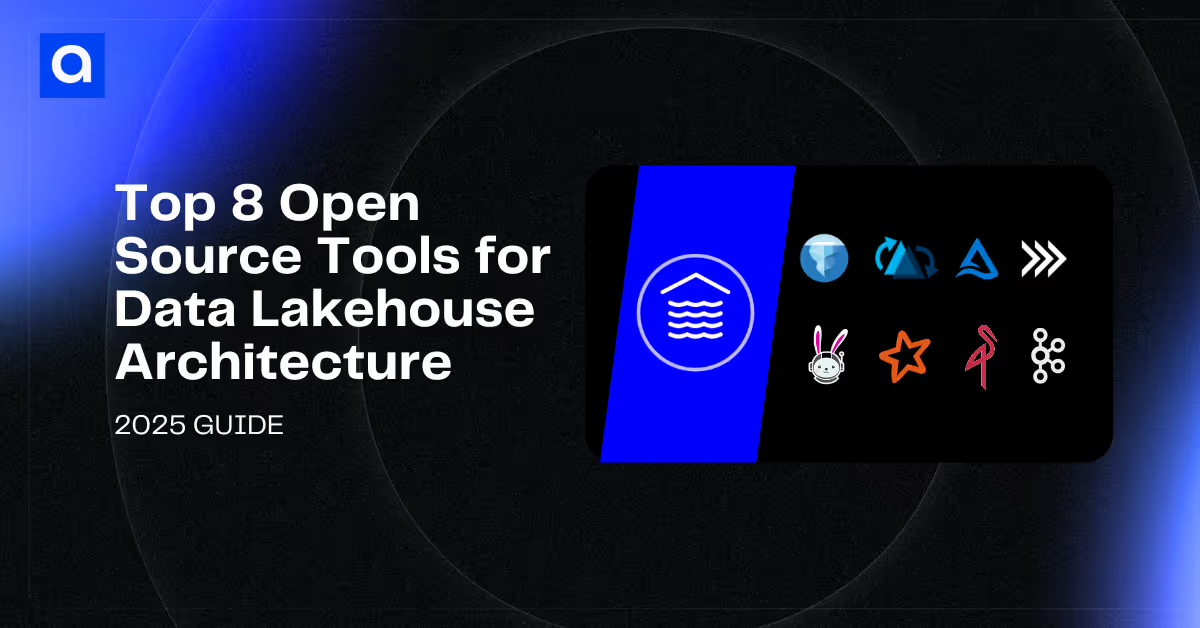
The data landscape is experiencing unprecedented growth. According to Grand View Research, the global data lake market size was estimated at USD 13.62 billion in 2023 and is expected to grow at a compound annual growth rate (CAGR) of 23.8% from 2024 to 2030, reaching USD 59.89 billion by 2030. This growth means organizations must rethink their data strategy and start migrating, however slowly, from traditional data lakes to modern data lakehouse architectures that provide flexibility and performance.
Data lakehouse solutions allow organizations to utilize both the advantages of data lakes and the performance and reliability of data warehouses, as they function as hybrid options to store and use data at a massive scale while supporting ACID transactions, schema evolution, and time travel.
As companies strive to save money, many are looking for data lakehouse vendors as alternatives to costly proprietary platforms.
In this detailed guide, we will look at the eight best open-source data lakehouse tools that constitute the foundation of a contemporary data lakehouse architecture.
You'll discover how table formats like Apache Hudi, Iceberg, and Delta Lake work alongside compute engines such as Spark and Trino, plus supporting technologies including Arrow, Kafka, and MinIO.
Each data lakehouse tool serves a specific purpose in creating scalable, efficient data platforms that can handle everything from real-time streaming to complex analytics.
Quick Comparison: Top 8 Data Lakehouse Tools
1. Apache Hudi - The Incremental Processing Pioneer
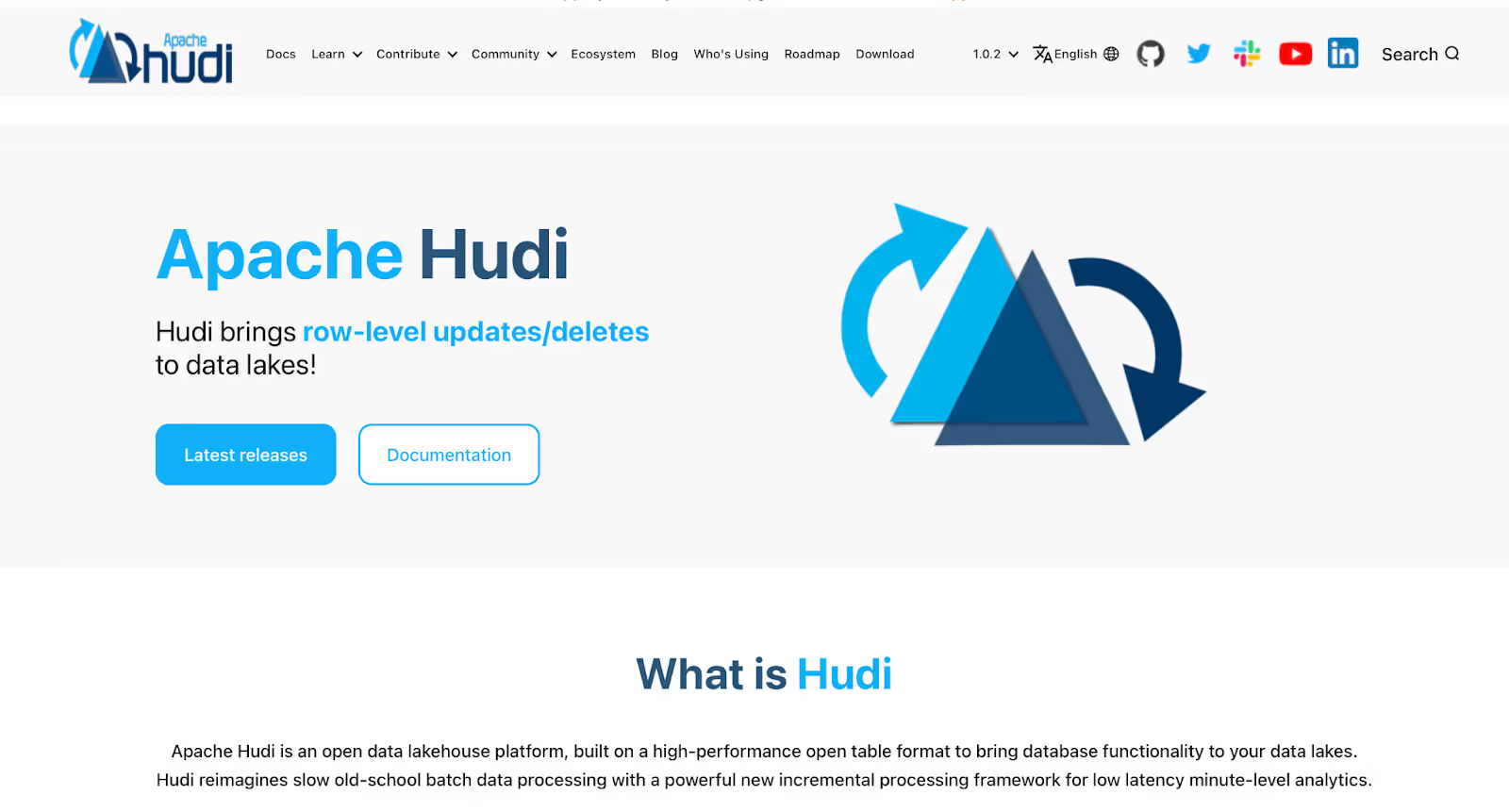
Apache Hudi is the original data lakehouse platform and the first to offer incremental processing and real-time analytics on data lakes. Hudi was created at Uber to handle petabyte-scale data that required frequent updates and deletes, and has become the de facto choice for organizations that need real-time data processing capabilities.
Hudi uses indexing techniques for fast updates and deletes and supports two types of tables, the first is Copy-on-Write (CoW) for read-heavy and Merge-on-Read (MoR) for write-heavy.
At Azumo, we've worked with Apache Hudi when building data pipelines that required near-real-time updates and frequent record-level changes, especially for clients with large-scale ingestion needs. In our experience, Hudi shines when you need reliable change data capture (CDC) and efficient incremental processing. It's not always the easiest to set up, but once integrated, it dramatically cuts down on reprocessing overhead.
Key Features:
- Incremental Processing - With native support for change streams, it lets you build incremental pipelines that cut down on unnecessary processing and keep costs from spiraling out of control
- Multi-Modal Index - Whether you’re doing point lookups or handling tricky update patterns, Hudi’s multi-modal index can speed things up dramatically (we're talking 10x to 100x in some cases)
- Copy-on-Write and Merge-on-Read - Different jobs need different storage layouts. Hudi gives you both: Copy-on-Write for read-heavy tasks and Merge-on-Read when write speed is what matters most. You don’t have to compromise
- DeltaStreamer - DeltaStreamer might sound like a buzzword, but it’s actually a workhorse. It pulls in change data from Kafka, JDBC, S3 events, you name it, and keeps things running smoothly.
- Advanced Concurrency Control - Hudi’s optimistic concurrency control handles these with grace, even when multiple jobs are hammering the same folder
Use Cases:
- Real-time Analytics - Streaming data ingestion with sub-minute latency requirements
- Change Data Capture: Processing database changelogs and maintaining synchronized data lakes
- Mutable Workloads - Scenarios requiring frequent updates, deletes, and data corrections
The community support for Hudi is impressive. According to Onehouse, in December 2022, Apache Hudi had almost 90 unique authors contribute to the project, more than double the number for Iceberg and triple the number for Delta Lake.
Real-World Impact: ByteDance/TikTok manages over 400PB+ single table data volumes with PB-level daily increases using Hudi for their massive-scale analytics platform.
Bottom Line
Apache Hudi is one of the best open source data lake solutions, built for real-time processing and frequent data updates. It’s a great fit for teams that need more than just basic append-only data pipelines.
2. Apache Iceberg - The Cloud-Native Table Format
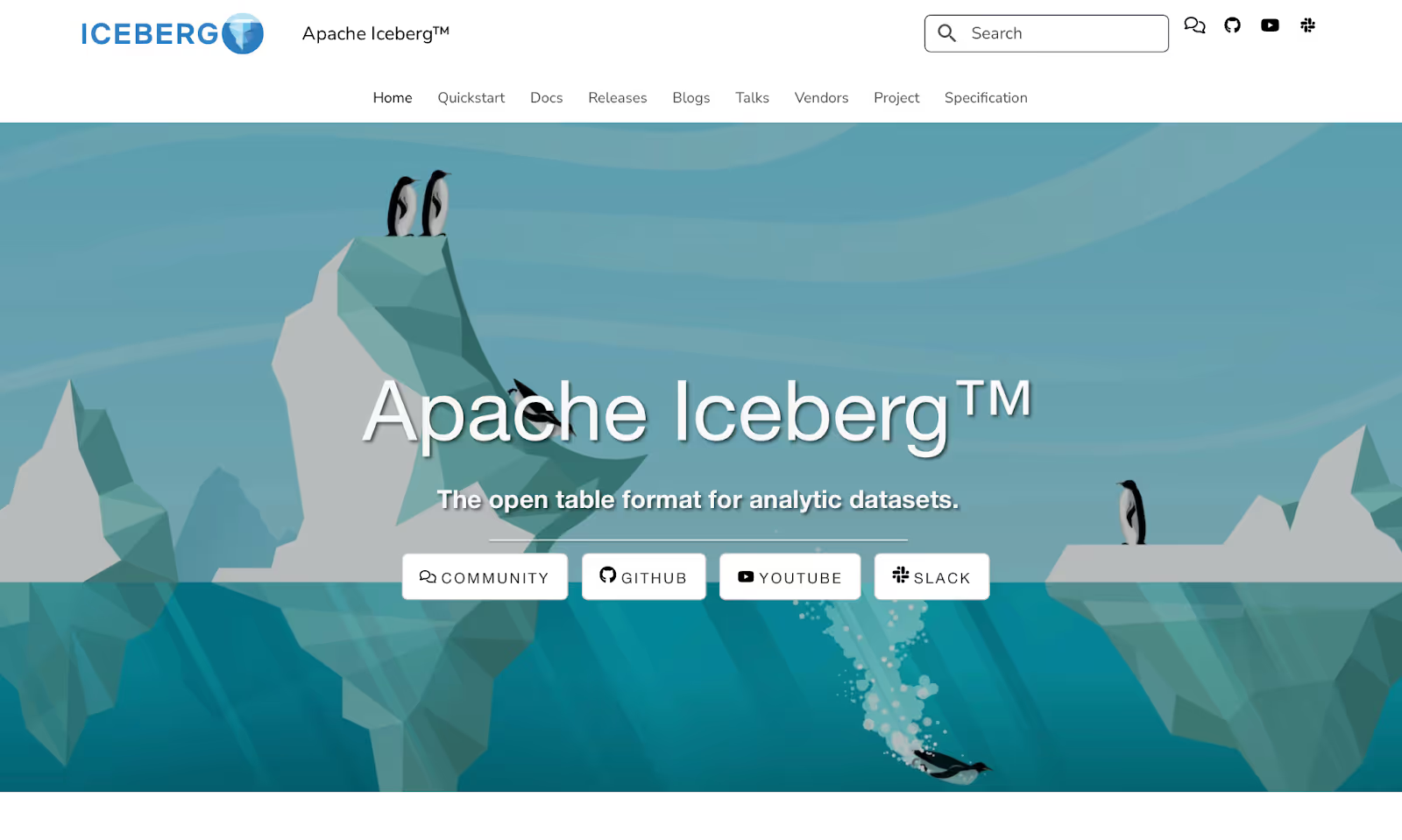
Apache Iceberg was created at Netflix to solve cloud storage scale problems and has become a cornerstone of modern data lakehouse architectures. According to Cloudera, Apache Iceberg is the key building block of the open lakehouse, bringing the reliability of SQL tables to big data while making it possible for multiple compute engines to work concurrently.
Iceberg's design philosophy centers around solving the fundamental challenges of working with large analytical tables in cloud environments. Its architecture allows seamless schema evolution and proactive and managed partition management without the usual operational burden of big data systems.
We’ve used Apache Iceberg in multi-engine environments where Spark wasn’t the only tool in play. Iceberg’s ability to support schema evolution and partitioning without downtime has been helpful when building flexible data layers that need to evolve over time. That said, performance can lag behind Hudi or Delta in high-speed scenarios, so we’re selective about when we deploy it, usually when cross-tool compatibility is the top priority.
Key Features:
- Hidden Partitioning - automatic partition management with no overhead on the user side for partition maintenance.
- Partition Evolution - Changing partitioning schemes without rewriting existing data
- Schema Evolution - Adding, dropping and renaming columns for evolving schema without downtime
- Time Travel - Query the historical version of the data using snapshots
- Multi-Engine Support - Spark, Trino, Flink, and many more compute engines supported.
Use Cases:
- Multi-Engine Analytics - Multiple compute engine scenarios querying the same data
- Schema-Intensive Workloads - Applications with strongly dynamic data structures
- Compliance & Auditing - Access situations to past data and ancestry tracking
Performance Considerations: While Iceberg offers excellent multi-engine compatibility, Onehouse research shows that Apache Iceberg consistently trails behind as the slowest of the major table format projects in performance benchmarks.
Bottom Line
Apache Iceberg is one of the most resourceful data lakehouse tools for organizations that require multi-engine compatibility and schema flexibility. It is especially useful for read-heavy analytics workloads and data structures that change frequently.
3. Delta Lake - The Databricks-Native Solution
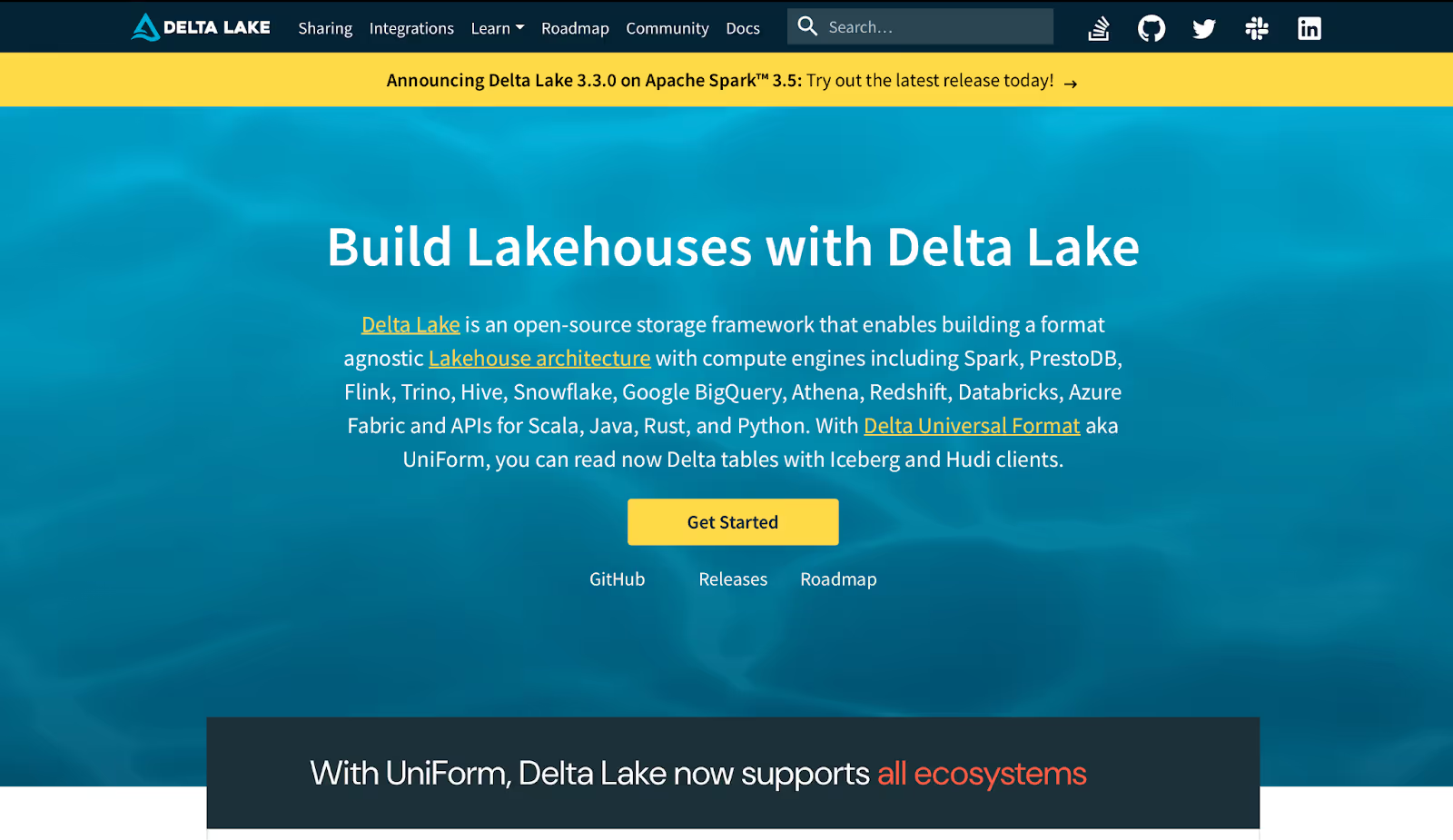
Delta Lake will always be significant in the data lakehouse timeline. Delta Lake was created by Databricks in 2017 as their table format for building the data lakehouse; it can be considered the first actual data lakehouse solution, so it certainly has a first-mover advantage.
The strength of Delta Lake is in its maturity and deeper integration in the entire Databricks ecosystem. It gives you things like ACID transactions, time travel, and scalable metadata on top of Parquet files, which is a big deal if you're trying to keep your data reliable and easy to work with over time.
We’ve used Delta Lake to enforce data quality and schema consistency for enterprise data lakes, and the time travel feature has proven genuinely useful during auditing and debugging. It performs best when you're already within the Databricks ecosystem, but we’ve also integrated Delta into broader stacks thanks to its growing engine and language support.
Key Features:
- ACID Transactions - Ensures data consistency and reliability in multi-writer scenarios
- Time Travel - Access and revert to earlier versions of data
- Schema Enforcement - Prevents bad data from corrupting tables
- Change Data Feed - Captures row-level changes for downstream processing
- Databricks Integration - Native optimizations when used with the Databricks platform
Delta Lake might seem closely tied to Databricks, but it’s actually much more versatile than you’d expect. As an open-source, format-agnostic technology, you can slot Delta Lake into almost any modern data stack. It works smoothly with tools like Spark, Trino, Flink, PrestoDB, and even with cloud platforms such as Snowflake and BigQuery. Plus, with support for multiple programming languages, including Scala, Java, Rust, and Python, it gives teams the flexibility to use whichever tools and workflows suit them best.
Use Cases:
- Databricks Ecosystems – For organizations that rely heavily on the Databricks platform, this ecosystem offers a robust and integrated environment to manage and analyze data efficiently.
- Batch Processing – Perfect for traditional ETL workloads where strong consistency and reliability are a must.
- Data Quality – Best suited for situations that demand strict schema validation and strong data governance, ensuring your data remains clean and trustworthy.
Community Strength: Delta Lake stands out as the most popular option, with more GitHub stars and greater community awareness than other major table formats. This means it’s easier to find developers, helpful resources, and community support when you need it.
Bottom Line
Delta Lake is a well-established data lakehouse tool. It offers strong ACID guarantees and integrates smoothly with Databricks, making it a great choice for organizations that care about data quality and want tight Databricks integration.
4. Apache Spark - The Unified Analytics Engine
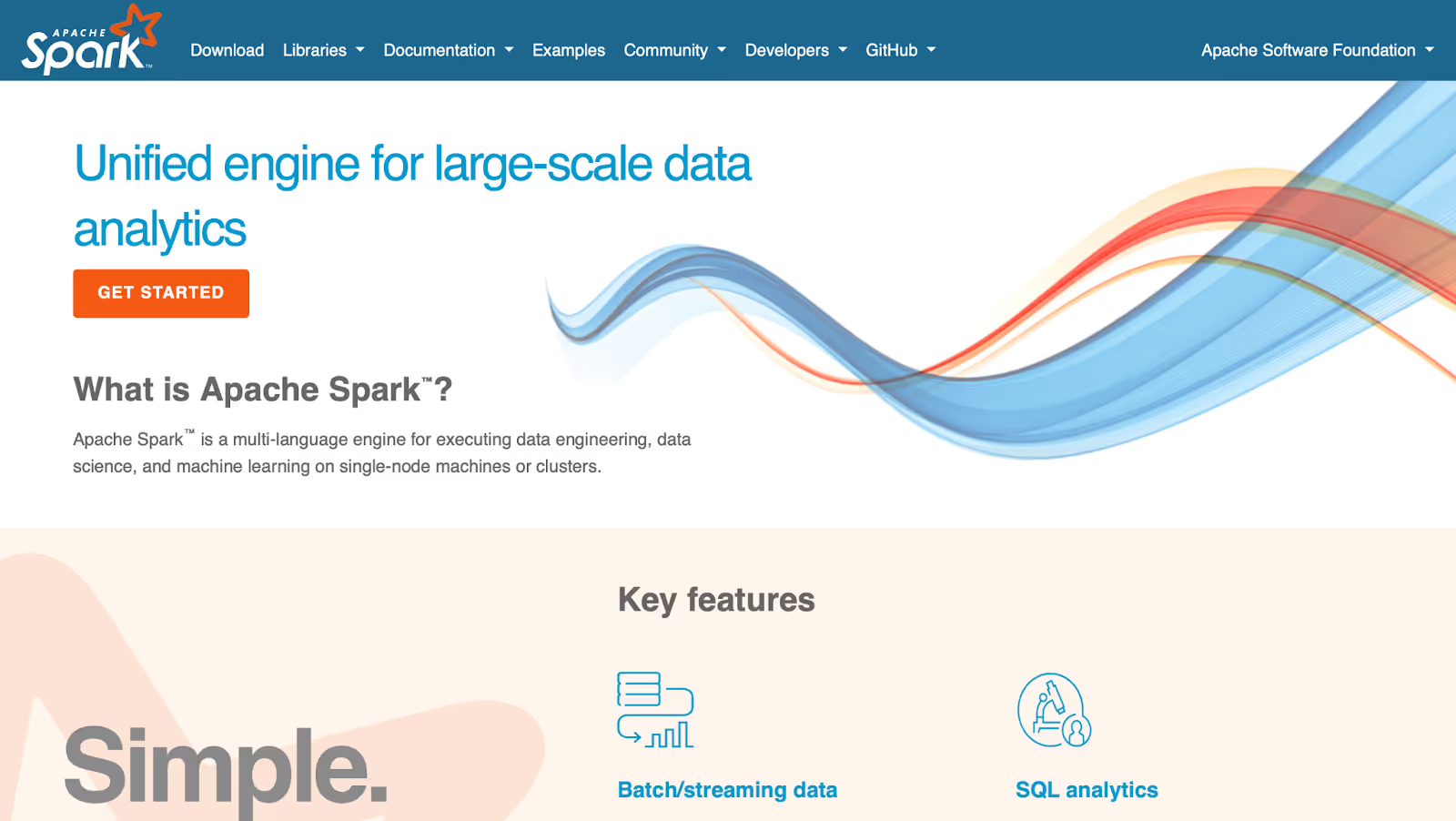
Apache Spark serves as the computational backbone of most data lakehouse architectures, providing unified batch and stream processing capabilities across all major table formats. The lakehouse is underpinned by widely adopted open source projects Apache Spark, Delta Lake, and MLflow.
Spark makes life easier by letting you handle all your data processing needs, batch jobs, real-time streaming, machine learning, and even graph analytics, using one tool. Instead of juggling multiple systems, you get a single, easy-to-use API and engine that keeps things simple and consistent.
Apache Spark is foundational to a lot of the work we do at Azumo, especially in large-scale ETL jobs and machine learning pipelines. Our data engineers use Spark for both real-time and batch processing. While Spark can be resource-heavy, its flexibility and performance with in-memory processing make it our go-to when building unified data workflows across cloud or hybrid environments.
Key Features:
- Unified Processing - Spark can perform batch jobs, stream processing, machine learning, and even graph computations
- Multi-Format Support - It has native support for Hudi, Iceberg, and Delta Lake integrations so that you can choose the format that best fits your use case
- Structured Streaming - Structured Streaming enables you to build real-time pipelines with end-to-end guarantees like exactly-once delivery
- MLlib Integration - No necessity for an isolated machine learning platform, Spark's MLlib performs most common tasks.
- Query Optimizer - Spark optimizes and rewrites queries automatically using its Catalyst engine, thereby optimizing performance without extra tuning
Use Cases:
- ETL Processing - Complex data transformations and pipeline orchestration
- Real-time Analytics - Streaming data processing with low latency requirements
- Machine Learning - Feature engineering and model training workflows
Spark fits right in with just about any setup. It works smoothly with all the major table formats, cloud services, and data sources, making it a go-to choice for organizations building full-featured data platforms.
Performance Perks: Because Spark processes data in memory and uses smart optimization techniques, it’s great for tasks that need to run repeatedly or for fast, interactive analytics. This means you get much faster results compared to old-school, disk-based systems.
Bottom Line
Apache Spark pulls a lot of weight in the data lakehouse stack. It processes data across formats like Hudi, Iceberg, and Delta Lake, and supports batch jobs, streaming, and machine learning, all in one system. If you want one engine to handle most of your workloads, Spark usually fits the bill.
5. Apache Trino - The Distributed SQL Engine

Trino stands out for one simple reason: it lets you run fast SQL queries across all your data, no matter where that data lives. Whether it's in your data lake, a relational database, a cloud warehouse, or even a streaming platform, Trino acts as a single access point. That’s why Starburst Galaxy uses it to streamline modern data lakehouse architectures.
Trino isn’t really meant for batch jobs. Instead, it shines when you need to run interactive analytics or ad hoc queries that deliver results in seconds, not minutes. With its focus on speed and flexibility, Trino is perfect for quickly exploring large datasets whenever you need answers fast.
We’ve used Trino to help clients unify access to distributed data sources, whether they live in cloud warehouses, object storage, or legacy databases. It’s especially useful for building interactive dashboards or analytics layers without having to duplicate data. The learning curve can be steep for some teams, but once configured, Trino delivers serious value in federated querying.
Key Features:
- Query everywhere - Join data from multiple systems in one SQL statement—lakehouse, warehouse, or OLTP.
- Quick results - Its vectorized execution engine and caching help deliver sub-second performance for dashboards and business queries.
- Broad integrations - Out-of-the-box connectors for over 40 data sources, including Hudi, Iceberg, Delta Lake, MySQL, and S3.
- Smart planning - Cost-based optimization ensures queries run as efficiently as possible, even across large datasets.
- Resilient design - Trino is built to handle long-running or complex queries without falling apart under pressure
Use Cases:
- Data Federation - Querying across multiple data sources and formats
- Interactive Analytics - Fast ad-hoc queries for business intelligence
- Data Virtualization - Creating logical views across distributed data sources
What makes Trino powerful is how it lets you use SQL to access and combine data from all kinds of sources. With Trino, you can join information from your data lakehouse with data in traditional databases, cloud storage, or even streaming platforms, all in one query. It’s a simple way to bring everything together.
Trino is also built for speed. Thanks to its smart caching and vectorized execution engine, you can run queries on huge datasets and get results in less than a second. That makes it perfect for interactive dashboards and real-time analytics.
Bottom Line
Trino is one of those data lakehouse tools that teams can use to explore and analyze data without worrying about where it lives. It brings the speed of a warehouse and the flexibility of a lakehouse together under one SQL layer, and that makes it a key part of any modern data stack.
6. Apache Arrow - The In-Memory Columnar Format

Apache Arrow gives us a common, standardized way to organize data in columns, making analytical tasks run faster and allowing different systems to easily share information. As Dremio points out, using open-source tools like Apache Arrow, Apache Iceberg, and Nessie in data lakehouse setups has really changed the game. These tools have helped build data management systems that are more flexible, scalable, and efficient than ever before.
It’s hard to overstate how much Arrow has changed the world of data. By giving everyone a shared way to store data in memory, it removes the usual slowdowns from converting data between formats. This means different systems, and even different programming languages, can share data instantly, without copying or extra processing.
Arrow is one of those libraries we use without even knowing it, since it's often included in other libraries that we build with, like Spark or Pandas. Our engineers really appreciate the way it reduces data exchange friction across languages and systems. It's not always something that clients consciously realize, but it certainly improves system performance and design under the hood.
Key Features:
- Columnar layout - Optimized for fast, vectorized analysis and efficient use of memory
- Zero-copy sharing - Systems can access a shared piece of data without serializing it twice
- Multi-language - C++, Java, Python, R, and other languages are supported
- Flight RPC - High-speed, light-weight data-moving protocol
- Built-in compute kernels - Domain-specific functions for common analytics operations
Use Cases:
- Analytics Acceleration - Speeding up queries by working directly with columnar data in memory
- Data Integration - Sharing data between tools without conversion overhead
- In-Memory Processing - Powering analytics where speed and efficiency are essential
Arrow stores data in columns instead of rows, which is a game-changer when you’re working with big data. Instead of processing one row at a time, Arrow lets you handle whole columns at once. This means analytical tasks, like crunching huge numbers, happen much faster and more efficiently. It’s a practical way to speed up the kinds of queries and reports that analysts rely on every day.
Most people using tools like Spark or Pandas don’t realize Apache Arrow is working in the background. It’s not flashy, but it plays a big role, letting different systems pass data back and forth without wasting time on conversions. That shared memory format? That’s Arrow, quietly speeding things up without making a fuss.
Bottom Line
Apache Arrow is one of those essential data lakehouse tools that does its job quietly but effectively. Its memory-first design speeds up analytics without adding complexity, making it easier for teams to move data around and get insights faster. You won’t see it front and center, but Arrow is what keeps a lot of modern data workflows running cleanly in the background.
7. Apache Kafka - The Streaming Platform

A lot of real-time data pipelines rely on Apache Kafka, and for good reason. It’s often the piece that keeps everything flowing. Kafka works behind the scenes to move data from operational systems into analytics platforms, without delays or bottlenecks.
Kafka is built to handle that chaos. Its distributed, publish-subscribe system means your data keeps flowing smoothly without drama, no matter how much you throw at it. This is why so many modern open source data lakehouse solutions count on Kafka: it’s versatile enough for real-time streams and batch jobs alike. It doesn’t matter if you’re collecting real-time user data or syncing systems halfway around the world, Kafka keeps the pipeline running smoothly.
Kafka is a staple in our real-time ingestion and event-driven architecture projects. We’ve used it to connect operational systems with analytics platforms, especially when building systems that require low-latency data delivery and high durability. Setting it up properly takes time, but for clients that need constant data movement, Kafka’s reliability is worth it.
Key Features:
- High Throughput - Processes millions of events per second with minimal latency
- Durability - Your messages are stored durably, and you have control over how long to store them, no matter what happens
- Scalability - Scales out across servers as your needs change easily
- Connect Framework - Comes with connectors to your favorite databases, storage systems, and cloud platforms
- Schema Registry - Handles all the behind-the-scenes rules and transformations so your data flows smoothly
Use Cases:
- Real-time Ingestion - Streaming data from operational systems to data lakes
- Change Data Capture - Capturing database changes for analytical processing
- Event-Driven Architecture - Building reactive data pipelines
Kafka fits right in with data lakehouse tools. It teams up naturally with Apache Hudi for real-time updates, Spark Structured Streaming for handling streams, and supports different table formats to keep data flowing in without interruption.
How does Kafka perform? It can move huge amounts of data quickly, without slowing down, which means it’s great for everything from big batch jobs to real-time streams. And because it’s built as a distributed system, you get fault tolerance and scalability out of the box.
Bottom Line
If you need to build real-time data pipelines or event-driven systems, Apache Kafka is a top data lakehouse tool. It’s made for teams that want fast, reliable data movement, supporting low-latency, high-throughput, and nonstop ingestion from lots of different sources. From tracking changes in your data to powering live dashboards, Kafka keeps things running without a hitch.
8. MinIO - The Cloud-Native Object Storage
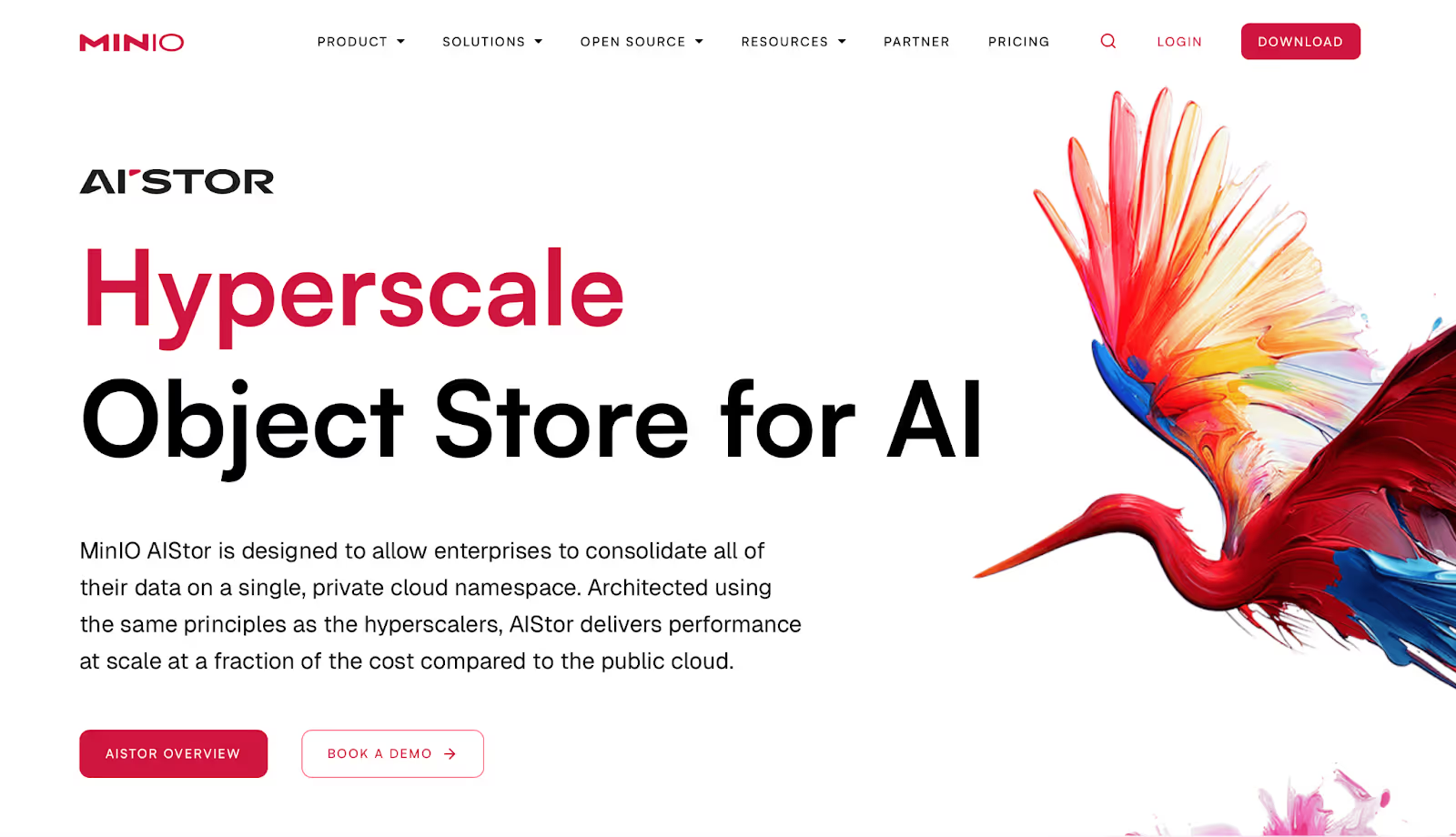
MinIO provides high-performance, S3-compatible object storage that serves as the foundation layer for data lakehouse architectures, offering cost-effective alternatives to cloud storage.
At its core, MinIO delivers blisteringly fast, S3-compatible storage that plays nicely with your existing data tools while giving you complete control over where and how your data lives.
MinIO’s engine, AIStor, was designed with AI-scale in mind. We're talking throughput north of 2.2 TiB/s, active-active replication across sites, and the ability to stretch a single namespace across thousands of distributed nodes. This isn’t theoretical, it’s production-grade, used in environments where performance is non-negotiable.
MinIO runs on your hardware, on your terms; whether that’s Kubernetes in the cloud, x86 in a colo, or ARM on the edge. And it does it all with enterprise-grade features like zero-cost encryption, its own S3-aware firewall, granular object immutability, and built-in lifecycle management.
We’ve deployed MinIO in hybrid cloud environments for clients who needed full S3 compatibility without tying themselves to AWS. Its performance has been excellent in our experience, particularly for AI workloads that require fast, local object storage. MinIO gives teams more control over their storage stack while keeping costs predictable, and it fits well with Kubernetes-native deployments we’ve built.
Key Features
- S3 Compatibility: Full compatibility with Amazon S3 API, enabling seamless migration and integration with existing S3-based applications and tools.
- High Performance: Optimized for large-scale data operations with high throughput and low latency for both read and write operations.
- Kubernetes Native: Designed specifically for container orchestration environments, making it ideal for modern cloud-native deployments.
- Multi-Cloud: Runs consistently across any cloud provider or on-premises environment, providing true hybrid and multi-cloud capabilities.
- Data Protection: Built-in encryption, versioning, and lifecycle management features for comprehensive data protection and governance.
Use Cases
MinIO is ideal for cost optimization, reducing cloud storage costs with on-premises or hybrid deployments. It excels in data sovereignty scenarios where organizations need to maintain data control and meet compliance requirements, and hybrid cloud environments requiring consistent storage across multiple environments.
Bottom Line
MinIO puts you in the driver’s seat when it comes to managing your data. It’s a flexible data lakehouse solution that lets organizations keep complete control over where and how their information is stored, all while staying cloud-friendly. If your team is watching costs closely or has to meet strict compliance standards, MinIO has your back. Because it works with the S3 API and runs smoothly in hybrid or multi-cloud environments, it’s a solid fit for many different organizations.
Essential Criteria for Choosing Data Lakehouse Technologies
Picking the right tools for your data lakehouse setup really depends on what you’re working with, and what you’ll need down the line. It’s not just about features; it’s about how everything fits together for your team, your data, and how things scale over time.
Performance Requirements
Think about how fast your queries need to run, how much data you’re writing, and how long it takes to get from raw input to usable output. Real-time analytics has a totally different pace than batch jobs, so your tools should match how you actually work.
Scalability Needs
Consider your data volume growth projections, concurrent user requirements, and compute scaling capabilities. Some tools excel at horizontal scaling while others have limitations at extreme scales.
ACID Compliance
If you’re working with data that gets updated a lot, or you’ve got multiple systems writing to the same tables, then solid ACID support isn’t optional. Delta Lake and Apache Hudi both handle that well, they support full transactions and enforce schemas, which helps keep things consistent and avoids messy surprises in production.
Compatibility & Ecosystem Integration
Most modern data stacks aren’t built around a single tool, so flexibility really does matter. Iceberg makes that easier by working with multiple engines like Spark, Trino, and Flink. Trino itself supports connections to dozens of data sources, and Arrow helps data move cleanly between systems and languages without extra conversion steps. If your setup involves different tools, or is likely to change, these give you options without locking you in.
Real-Time vs. Batch Needs
Some teams need real-time ingestion, while others work in batch cycles. If your priority is event-driven pipelines, Kafka and Hudi are your go-to. For traditional batch ETL, Delta Lake and Spark are battle-tested. Ideally, your stack should allow both: many of these tools integrate well to give you hybrid workflows.
Cloud-Native and Deployment Flexibility
Not all infrastructures are created equal. If you're running on Kubernetes or across hybrid/multi-cloud environments, MinIO offers unmatched flexibility with its software-defined, S3-compatible design. Tools like Arrow, Kafka, and Spark are container-friendly and cloud-native.
Wrapping It Up: Choosing the Right Tools is Only Half the Battle
There’s no one-size-fits-all solution when it comes to building a modern data lakehouse. The right mix of tools depends on what your data looks like today, and what you expect it to look like six months from now. Whether you’re dealing with fast-moving streams, massive historical datasets, or just trying to break out of a tangled legacy setup, open-source tech like Hudi, Iceberg, Trino, and the rest can give you the building blocks you need.
But tools alone don’t build solutions. That’s where the real work starts—and that’s where we come in.
At Azumo, our team of data engineers has worked hands-on with many of the technologies featured here. We’ve helped organizations stand up their first streaming pipelines, refactor broken ETL systems, and modernize their data infrastructure without starting from scratch.
If you’re thinking about moving to a lakehouse model, or stuck somewhere in the middle, we’d love to help.
FAQs
Are there open-source alternatives to Delta Lake that still provide ACID guarantees for analytic workloads?
Absolutely. Apache Hudi and Apache Iceberg both provide full ACID guarantees. Hudi was actually built at Uber specifically for handling frequent updates and deletes at petabyte scale. We've used it for CDC pipelines where ACID compliance was non-negotiable. Iceberg also supports ACID transactions and is great when you need multi-engine compatibility. Both are mature, production-ready alternatives to Delta Lake with strong community support.
What is the best data lakehouse architecture software?
The core stack we typically deploy includes Apache Spark for unified processing, one of the table formats (Hudi, Iceberg, or Delta Lake) for storage, and Trino for fast SQL queries. Apache Kafka handles real-time ingestion when needed. MinIO provides S3-compatible storage if you want control over your infrastructure. Arrow accelerates everything behind the scenes. The "best" combo really depends on your workload, but Spark + Iceberg + Trino covers most use cases well.
What are the top data lakehouse platforms?
For open source, Apache Hudi, Iceberg, and Delta Lake are the big three table formats. Hudi excels at real-time updates and streaming. Iceberg is best for multi-engine environments. Delta Lake integrates tightly with Databricks. For compute, Spark handles most workloads while Trino is great for interactive queries. These aren't platforms in the traditional sense but rather composable tools you build with.
What are lakehouse development tools similar to Databricks?
If you want Databricks-like functionality with open source, combine Apache Spark with Delta Lake or Iceberg, add a notebook interface like Jupyter or Zeppelin, and use workflow orchestration tools like Airflow. For managed alternatives, check out platforms built on these open-source tools. Honestly though, replicating the full Databricks experience takes work. Most teams either use Databricks or build custom stacks focused on their specific needs rather than trying to clone everything.
What are the best lakehouse solutions for time-series and IoT data 2025?
Apache Hudi is probably your best bet for IoT and time-series workloads. Its incremental processing and efficient upserts are perfect for sensor data that arrives constantly. Combine it with Kafka for real-time ingestion and Spark Structured Streaming for processing. Hudi's Merge-on-Read tables handle write-heavy IoT scenarios well. We've deployed this stack for clients with millions of IoT events per day. The key is tuning Hudi's compaction settings for your write patterns.
What are the top vendors for building a modern data lakehouse?
If you're talking open source, you're building with Apache projects rather than buying from vendors. The stack is Hudi/Iceberg/Delta Lake for storage, Spark for compute, Kafka for streaming, MinIO for object storage. If you want commercial support, Databricks backs Delta Lake, Confluent supports Kafka, and companies like Cloudera offer managed versions of these tools. We help clients build custom stacks when they need control or integrate managed services when simplicity matters more.
What are the top flash-based data lakehouse platforms?
Flash storage is more about the infrastructure layer than the lakehouse software itself. That said, MinIO performs exceptionally well on NVMe flash storage, pushing over 2.2 TiB/s throughput. We've deployed it on flash-backed Kubernetes clusters for AI workloads where I/O speed matters. Apache Hudi and Spark also benefit significantly from flash storage for write-heavy workloads. The key is pairing fast table formats like Hudi with NVMe-backed object storage. Most cloud providers now offer flash-optimized instance types that work well with these open-source tools.


.avif)
